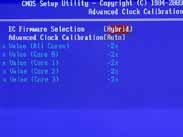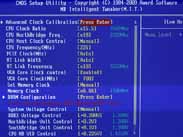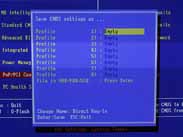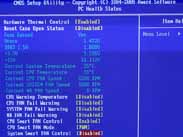Rear I/O
Included on the rear I/O is a solid complement of HTPC features, although Gigabyte stops short of more elaborate ones that Asus' specifically designed HTPC range includes, such as gold plated coaxial stereo outputs.- PS2 keyboard or mouse
- Six USB 2.0 ports
- d-Sub video
- DVI-D
- HDMI 1.3
- optical S/PDIF out
- one 6-pin Firewire port
- one eSATA port
- one RJ45 Gigabit Ethernet socket
- six 3.5mm audio jacks providing 7.1 channel High-Definition audio with microphone and line-inputs
This will be the only time we like the choice between PS2 keyboard and mouse considering some older IR remote controls might still use the PS2 mouse input. Six USB 2.0 is plenty but it's a shame we don't have powered eSATA here.

BIOS
Gigabyte's BIOS, for a sub £70 motherboard, is fantastic. Not only is there integrated core unlocking but the features included offer a huge injection of ease of use. In its MIT section the clock ratios (multipliers) and clock rates (MHz) dynamically adjust the readings to the right of them.
The voltages work in the method of "in addition to" the stock voltages, which we've criticised before for not knowing where this puts them. This time Gigabyte has avoided criticism by including the actual whole value to the right as a reference. The downside is that the voltages offered lack finesse, as ~0.15-0.1V is as small as they go, but it's to be expected given the board's price and target market. This does limit it a bit for overclocking as you'll see later, but it certainly doesn't mean it's incapable.
Gigabyte's 785G offers core clocking to an optimistic 2GHz, although the voltage option is limited to an extra 0.3V, but given the size of the heatsink and the inferno effect we saw by overvolting it that much, we can see why.
Under the Advanced Clock Calibration section is the key to Gigabyte's awesomeness here: the EC Firmware Selection. For those with triple and dual core CPUs based on the original Agena that has cores hidden, selecting "Hybrid" and Auto under ACC control in this section can potentially unlock them without the need to reboot.
We say potentially because it's certainly not a guaranteed result - it depends on your CPU - and even then the fourth core might not be stable or it could limit your total overclock. However, if it does work the benefits are clear - you can have a quad core for a fraction of the price! It's not a permanent setting by any means, it can be set back either by either resetting it back to "normal" in the BIOS or clearing the CMOS.
Outside of this the features are pretty usual to Gigabyte - in BIOS flash utility, CMOS saving and limited but working fan speed control.

MSI MPG Velox 100R Chassis Review
October 14 2021 | 15:04













Want to comment? Please log in.